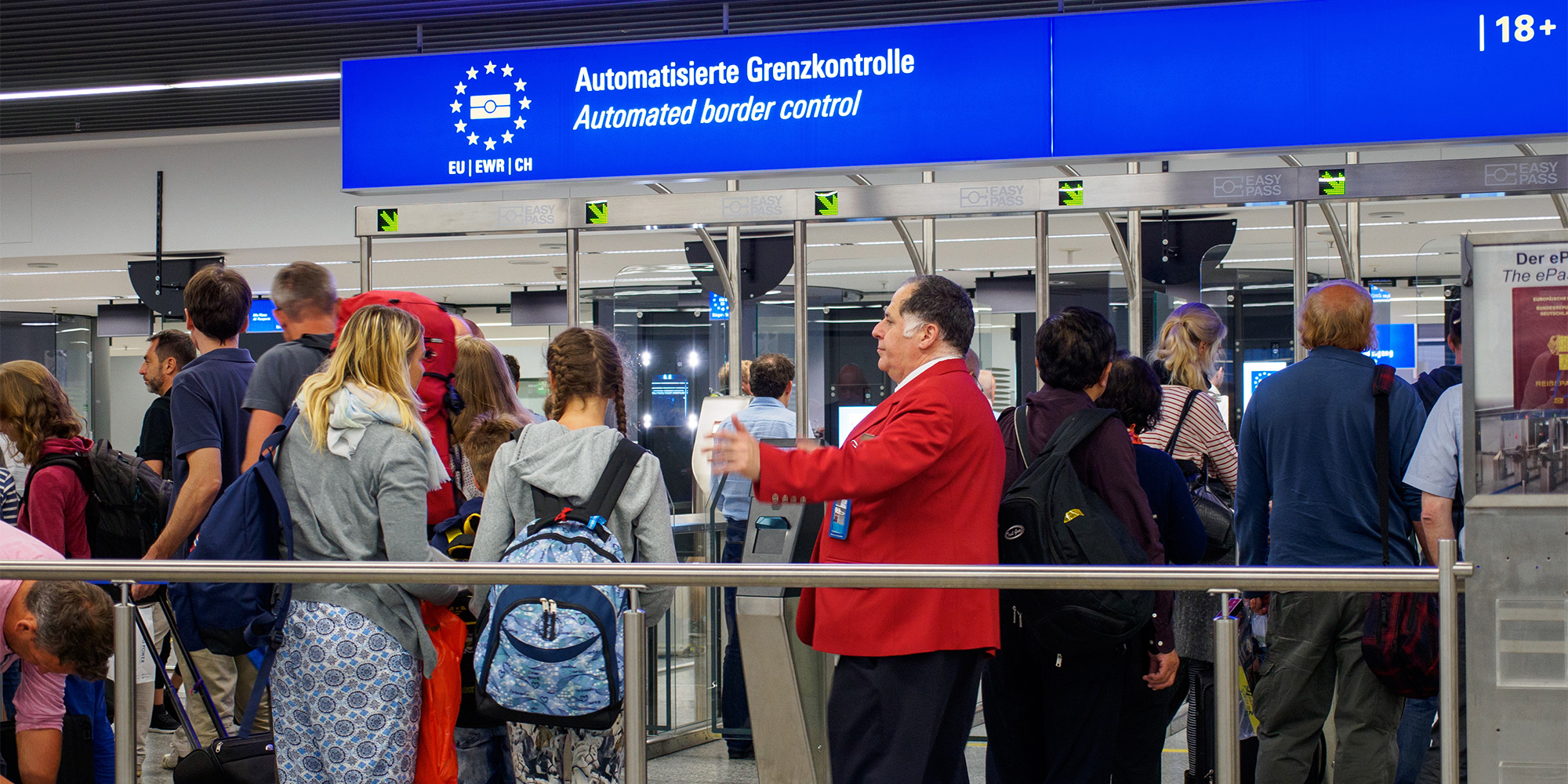
Get a year of super-useful advice
Who to book with, how to get the best deals plus inspiring destination ideas from the experts, for only £36.75 for the year – that’s 25% off.
Join Which? TravelOffer ends 8th January 2026

The EU has introduced new border checks, known as the Entry/Exit System, or EES, which may lead to longer queues for UK passport holders.
These changes, which are called the Entry/Exit System (EES), will mean that all third-party nationals arriving in Schengen countries, including UK passport holders since Brexit, will need to register their biometrics. This involves having your fingerprints and/or a facial scan taken at dedicated EES kiosks, or by a border officer, as well as answering questions about the reason for your visit.
This takes place on your arrival at European airports or, with Eurostar and the Port of Dover, before you clear French passport control in the UK.
The warning about longer queues is because registering for EES takes a few minutes. However, the checks are being rolled out slowly, with only a handful of airports operating EES. Checks are in place at the Port of Dover, and for some Eurostar passengers.
The system will be fully implemented across the 29 Schengen countries by April 2026. That includes popular holiday destinations such as Spain, France and Italy, but not Ireland or Cyprus.
If you’re travelling to or from Europe, here’s what you need to know for a hassle-free trip.
The new digital Entry/Exit System requires all non-EU passport holders, including those with British passports, to be fingerprinted and photographed at border control.
When the system is fully operational, travellers of all ages will be subject to these border checks, although children under 12 will not have to give fingerprints.
This will usually be done at new, dedicated automated kiosks or alternatively by a border officer when arriving overseas at airports and, for Eurostar/Eurotunnel and at the Port of Dover, before leaving the UK.
Visitors will also have to answer questions about the length of their stay and whether they have enough money to fund their trip
Although the system will ultimately replace passport stamping, for now, UK passport holders will still need to get their passport stamped at the border, in addition to EES checks.
Yes, although the launch date of 12 October 2025 was a progressive start date. There will be a gradual launch of different parts of the biometric system, in case of technical issues. This means that not all your biometric data will be collected when you next travel. Passports will continue to be stamped as usual until the full implementation from 10 April 2026.
It applies across all Schengen countries, including Bulgaria and Romania. The only exceptions are Ireland, which shares a Common Travel Area with the UK, and Cyprus, which will operate border controls separately.
It is being rolled out across Europe - Tallinn, Luxembourg Findel, Düsseldorf, Geneva and Basel are some of the airports to have introduced EES either fully or partially.
In some cases, such as in Prague, the new EES border checks have already led to long queues as airports adjust to new rules.
For more expertly researched destination ideas and unbiased travel advice and recommendations, subscribe to Which? Travel

Who to book with, how to get the best deals plus inspiring destination ideas from the experts, for only £36.75 for the year – that’s 25% off.
Join Which? TravelOffer ends 8th January 2026
Most people won't encounter the checks, initially because the roll-out is gradual. But it's difficult to be sure whether EES will be in place at your destination, as even airports that have introduced EES aren't registering all passengers.
Where the checks are in place, you will spend more time at the border, and that may lead to queues.
A UK government spokesperson said: 'While we have done everything we can to ensure the required infrastructure is in place, anyone who is planning a trip to the European mainland once these checks are introduced will still need to allow more time for their journey as the new EU systems bed in.'
The government has also warned that at juxtaposed ports - meaning where checks take place in the UK before departure - there might be longer waits during peak times, but that 'Eurotunnel, Eurostar and the Port of Dover have plans in place to minimise disruption as much as possible.'
No, apart from checking your passport validity and that you’re following the 90/180-day Schengen rule.
The UK government confirmed on 9 September that there’s no advance registration or paperwork needed before you travel.
However, it’s worth allowing extra time for your journey, following the UK government’s warnings about possible disruption and delays. For example, when booking transfers and car hire or other onward travel, take into consideration that you may wait longer than normal to exit the airport.
For peace of mind, you can also double-check the entry requirements of your destination by checking your its FCDO Foreign Travel Advice page.
EES launched on 12 October 2025 but it's a progressive roll-out, meaning different European countries will introduce different parts of this process in different phases.
The European Commission has confirmed that, until April 2026, your photo and fingerprints may not necessarily be collected at every border crossing, and your information may not necessarily be registered in the system. Passports will also continue to be stamped as usual until April 2026.
When fully rolled out, the EES will replace passport stamping and will help the EU to more closely track whether travellers are respecting the EU’s 90/180-day rule. This rule means British travellers cannot stay in the Schengen area for more than 90 days in any 180-day stretch.
Not yet. Although some airports, such as Faro and Rome Fiumicino, are already allowing UK travellers through the e-Gates - and it is hoped more will do so in future - that isn’t the case for now.
Even if you do go through an e-Gate, you’ll still get your passport stamped by a border guard afterwards. It’s crucial to approach the passport desk to have your passport stamped, otherwise you could face problems about the length of your stay.
You might be asked questions relating to funds to cover your stay or travel insurance when registering for EES, but there are no instances that Which? is aware of where UK tourists have been refused entry on the basis of not having travel insurance or evidence of funds.
There have been rumours of British tourists being fined under Spain’s '£97-a-day' rule but these are unfounded. The rule has long existed and technically applies to UK visitors following Brexit, but Spanish authorities confirmed to Which? that it isn’t enforced against British tourists, and none have been refused entry into Spain.
EES kiosks at St Pancras are currently asking extra questions, including whether travellers have ‘medical insurance’. Eurostar has indication that this is a mistranslation of ‘travel insurance.
Although answering ‘no’ may flag you in the system for additional checks, the UK government has since said that travel insurance isn’t a requirement for travelling to the EU under EES.
But travel insurance is important for any holiday and should be taken out as soon as you’ve booked a trip. This ensures you’re covered if illness before your departure forces you to cancel.
No. Just prepare for extra border checks. You may be able to pre-register on an app in future, but at the moment this isn't an option for UK travellers.
The EU has created an app, called Travel to Europe, that allows travellers to pre-register their passport information and facial image up to 72 hours before arriving at border crossing points. It's not yet available for download in the UK but is being piloted in Sweden.
The Home Office has confirmed to Which? that it will ‘look to encourage people to use the app when it’s available.’
In this case, EES checks will take place at kiosks on the UK side. The roll-out of these checks will be staggered until the end of 2025.
The Home Office says there are kiosks to register passengers before their journeys, confirming plans for 49 kiosks for Eurostar, 106 for Eurotunnel, and at Dover 72 for cars and 12 for coaches.
However, it has also warned of delays caused by EES across airports, the Eurotunnel, Eurostar and Port of Dover in a statement.
Another change British travellers should prepare for is the introduction of the European Travel Information and Authorisation System (Etias), otherwise known as a visa-waiver scheme, due in 2026.
When it kicks in, which isn't expected until late 2026, holidaymakers will need to apply online and pay a fee of €20 (around £17) before travelling. The authorisation is expected to be valid for three years, or until your passport expires.
Not yet. Etias has been postponed several times and is now expected in late 2026, after EES has fully launched. There will be at least a six-month transition period and then an additional grace period before it becomes mandatory for UK passport holders.
When Etias launches, UK travellers will need it to travel to all of the below states:
Austria, Belgium, Bulgaria, Croatia, Cyprus, Czechia (aka the Czech Republic), Denmark, Estonia, Finland, France, Germany, Greece, Hungary, Iceland, Italy, Latvia, Liechtenstein, Lithuania, Luxembourg, Malta, Netherlands, Norway, Poland, Portugal, Romania, Slovakia, Slovenia, Spain, Sweden and Switzerland.
It's currently unclear whether travellers will need one to visit non-Schengen microstates such as Andorra or Monaco.